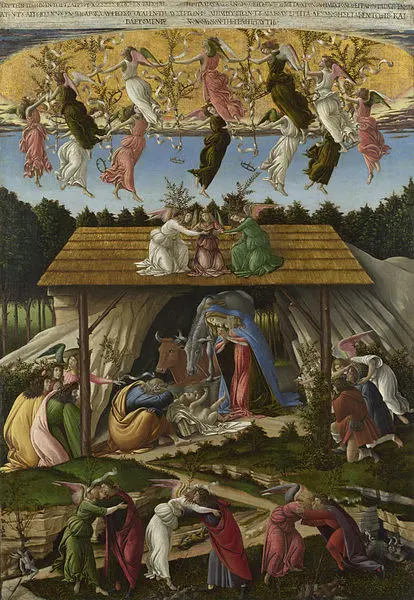
Word of the Day: Crèche
Today’s Word of the Day is crèche, courtesy of the The Dictionary Project. Crèche can refer to
- a representation or tableau of Christ’s Nativity, depicting the scene at the stable in Bethlehem, usually with statues or figurines;
- a hospital or home for abandoned babies;
- (primarily British) a day care nursery.
According to www.etymonline.com, the meaning of Christmas manger scene first appears in 1792, “from French crèche, from Old French cresche, crèche ‘crib, manger, stall’ (13c.), ultimately from Frankish or some other Germanic source; compare Old High German kripja, Old English crib (see crib (n.)). Also ‘a public nursery for infants where they are cared for while their mothers are at work’ (1854).
“A modern reborrowing of a word that had been in Middle English as cracche, crecche, criche ‘a manger, a place for feeding domestic animals’ (mid-13c.), from Old French creche. Wyclif (1382) has cracche (Luke ii.7) where Tyndale (1526) uses manger.”
In other words, English borrowed the word meaning a crib from French, but then later it referred specifically to the manger that held the Christ child, and then to the scene the is represented by small figurines or, sometimes, large figurines, or sometimes even by people who depict Mary, Joseph, and the baby.
According to the On This Day website, on this date in 1914, President Woodrow Wilson signed the Harrison Narcotics Tax Act (other sources claim that it was approved on December 17, 1914). This act regulated to the point of making illegal opiates and cocaine. Up until that point, throughout the 19th century, opiates and cocaine, as well as marijuana, were largely unregulated.
One of the chief arguments made by the progressives against opiates and cocaine was a decidedly racist one. According to Joseph D. McNamara, “The anti-drug arguments advocating the Harrison Act were replete with statements claiming that it was the duty of whites to save the inferior races. Those moving to criminalize drugs made references to Negroes under the influence of drugs murdering whites, degenerate Mexicans smoking marijuana, and “Chinamen” seducing white women with drugs. This racist nonsense would be laughed at today, but it was quite influential in the passage of anti-drug legislation” (http://www.hoover.org/publications/digest/3042936.html). In addition, the anti-drug campaign also was driven by Christian missionaries, particularly in China. According to McNamara, these American missionaries allied themselves with anti-alcohol advocates (the 18th Amendment, which created Prohibition, was passed in 1919 and went into effect in 1920).
According to McNamara, the racist arguments in favor of making drugs illegal were employed in order to persuade Southern politicians to support the bill. The Southern politicians were proponents of states’ rights, opposing federal involvement in affairs that were traditionally the purview of the states. According to Wikipedia, Dr. Hamilton Wright, who became the United States Opium Commissioner, testified before Congress that “drugs made blacks uncontrollable, gave them superhuman powers and caused them to rebel against white authority” (https://en.wikipedia.org/wiki/Harrison_Narcotics_Tax_Act#cite_note-1). The wiki adds, “Dr. Christopher Koch of the State Pharmacy Board of Pennsylvania testified that ‘Most of the attacks upon the white women of the South are the direct result of a cocaine-crazed Negro brain.’”
The inherent racism of drug laws persists to this day. In 2000, Jamie Fellner did a white paper for the US Dept. of Justice called “Punishment and Prejudice: Racial Disparities in the War on Drugs“ (https://www.ojp.gov/ncjrs/virtual-library/abstracts/punishment-and-prejudice-racial-disparities-war-drugs). And yet, since that time, nothing much has changed. Donald Trump imposed drug warrior Jeff Sessions on the country. Four years later, the nation elected drug warrior Joe Biden, who very dramatically pardoned people who had been convicted of federal marijuana violations but who were no longer in prison.
Perhaps someday we’ll return to the good old days when the government left people alone. Isaiah, in the ninth chapter, says,
For to us a child is born, to us a son is given, and the government will be on his shoulders. And he will be called Wonderful Counselor, Mighty God, Everlasting Father, Prince of Peace. Of the greatness of his government and peace there will be no end.
That Child taught us grace and mercy. That Child came to us in crèche in Bethlehem, in Judea. Perhaps someday we will learn to treat others the way we want to be treated.
Today’s image is Botticelli’s The Mystical Nativity. “This 1501 painting depicts a three-layered work that was quite common for this time period. It features the typical Nativity scene in the center while angels and light circle overhead. There are also angelic beings painted at the bottom third of the work. The infant Jesus, as well as the Virgin Mary and Joseph are featured in a cave that served as a makeshift manger that was mentioned in the Biblical story of Christ’s birth (https://www.artst.org/nativity-paintings/). Thanks to the Artst website.